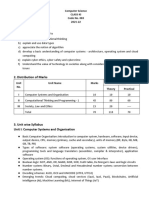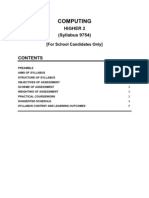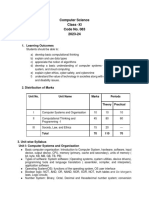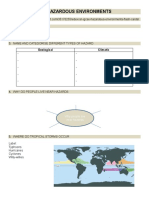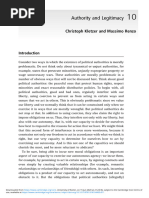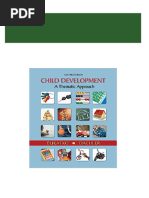Searching and Sorting Assignment: Computer Science - Grade 12
Uploaded by
sansSearching and Sorting Assignment: Computer Science - Grade 12
Uploaded by
sansSEARCHING AND SORTING PAGE 1 OF 1 MR.
WACHS: COMPUTER SCIENCE 40S
SEARCHING AND SORTING ASSIGNMENT
COMPUTER SCIENCE – GRADE 12
D ESCRIPTION :
Assignments for the grade 12 Computer Science course will be more open ended and (hopefully) creative than the problem set
given in previous grades
In grade 10, you did the specific problems I set out for you (problem 1, problem 2, etc.)
In grade 11 you had more choice from a collection of problems to do whichever problem(s) you felt was best for your learning
Now, in grade 12, you will have even more choice as now I mostly want you to design your OWN problem(s) to demonstrate your
learning to me on the specific unit content
D ETAILS :
You should design your own programming problem to demonstrate the specific learning outcomes for this unit (see below)
The problem may have a specific purpose (like a hypothetical company you are programming for) or just simple unit content
examples
You may design one problem to demonstrate the unit learning outcomes, or several
You may make the problem have a simple input/output system (e.g. System.out.println() and Scanner input, or
simple JOptionPane dialogs) or a more complex GUI
You may even carry one problem over unit to unit expanding on it each time to demonstrate the unit learning outcomes and
resubmitting it with its modifications for marking after each unit (this may even be incorporated into your final project)
Options: if you do not wish to make programming problems, you may demonstrate your learning in these other ways:
- Review notes: create a set of study notes for the unit either by hand or typed - do not just recopy my notes, but create
summary notes
- Video Tutorials: create a video screencast tutorial example(s) of how to learn the specific learning outcomes for the
unit and upload this to youtube (or give Mr. Wachs the video file) – if you are unsure how to do this, please see Mr. Wachs
for suggestions for software, etc.
M ARKING :
I will use the same marking rubric matrix that I used through grade 10 and expanded on through grade 11
This includes all eleven domains in: problem solving, commenting, design, data structures, algorithms, methods, style, usability, error
handling, success, and holistic approach
The mastery factor I will apply will be dependent on the problem(s) you design and will increase or decrease based on factors like:
- How many unit learning outcomes you demonstrate (breadth of knowledge)
- How complex your demonstration of learning outcomes is (depth of knowledge)
- How detailed your overall solution is in terms of size (lines of code), design, and practicality (usability, realism, etc.)
- How creative your
problem(s) are
U NIT L EARNING O UTCOMES :
Your problem(s) that you designed for this unit should demonstrate the following:
1. Students demonstrate an efficient linear search algorithm (through a method or class interface)
2. Students demonstrate an efficient bubble sort algorithm (through a method or class interface)
3. Students demonstrate an efficient selection sort algorithm (through a method or class interface)
4. Students demonstrate an efficient binary search algorithm (through a method or class interface)
SEARCHING AND SORTING THURSDAY, OCTOBER 31, 2013 MR. WACHS: COMPUTER SCIENCE 40S
You might also like
- Foa Reference Guide To Fiber Optics Study Guide To Foa Certification PDF FreeNo ratings yetFoa Reference Guide To Fiber Optics Study Guide To Foa Certification PDF Free27 pages
- Assignment 2 PST 2403 - Advanced Pedagogy in Comp Sci Ed - Munyararadzi ChavingiraNo ratings yetAssignment 2 PST 2403 - Advanced Pedagogy in Comp Sci Ed - Munyararadzi Chavingira8 pages
- Learning Outcomes: Computer Science Class-Xi Code No. 083 2021-22No ratings yetLearning Outcomes: Computer Science Class-Xi Code No. 083 2021-228 pages
- Computer Science Syllabus Break Up For O Levels 20-21No ratings yetComputer Science Syllabus Break Up For O Levels 20-2110 pages
- Learning Outcomes: Computer Science Class - Xi Code No. 083 2021-22No ratings yetLearning Outcomes: Computer Science Class - Xi Code No. 083 2021-2210 pages
- CS114 - Fundamentals of Programming: Qurrat-Ul-Ain Babar100% (1)CS114 - Fundamentals of Programming: Qurrat-Ul-Ain Babar80 pages
- Class XI,XII Curriculum Computer Science 2025-26No ratings yetClass XI,XII Curriculum Computer Science 2025-2630 pages
- Computer Science Unit 1 - Term 1 2022-2023No ratings yetComputer Science Unit 1 - Term 1 2022-20237 pages
- Programming Fundamentals Outlines For Session s2020 in Semester at March 9 2020No ratings yetProgramming Fundamentals Outlines For Session s2020 in Semester at March 9 20205 pages
- Computer Science Curriculum XI - XII 209 (01!08!19)No ratings yetComputer Science Curriculum XI - XII 209 (01!08!19)43 pages
- Objects First With Java A Practical Intr PDFNo ratings yetObjects First With Java A Practical Intr PDF5 pages
- K 12 CS Framework Statements Grade Band View AbridgedNo ratings yetK 12 CS Framework Statements Grade Band View Abridged13 pages
- Zahir Curriculum Study Unit Plan PortfolioNo ratings yetZahir Curriculum Study Unit Plan Portfolio6 pages
- Coding Fundamentals - Block 1 Lesson 6 - Revisiting BiomesNo ratings yetCoding Fundamentals - Block 1 Lesson 6 - Revisiting Biomes9 pages
- Autodesk 3ds Max 2023 for Beginners: A Tutorial Approach, 23rd EditionFrom EverandAutodesk 3ds Max 2023 for Beginners: A Tutorial Approach, 23rd EditionNo ratings yet
- Autodesk 3ds Max 2024 for Beginners: A Tutorial Approach, 24th EditionFrom EverandAutodesk 3ds Max 2024 for Beginners: A Tutorial Approach, 24th EditionNo ratings yet
- Omputer Cience: Today: Searching and SortingNo ratings yetOmputer Cience: Today: Searching and Sorting66 pages
- Package: .Java - Representation of A Generic Node For Use W Withab Binary o ObjectNo ratings yetPackage: .Java - Representation of A Generic Node For Use W Withab Binary o Object9 pages
- Omputer Cience: Today: Permanent StorageNo ratings yetOmputer Cience: Today: Permanent Storage73 pages
- Dawes-Galileo and The Conflict Between Religion and Science PDFNo ratings yetDawes-Galileo and The Conflict Between Religion and Science PDF287 pages
- Vaydika: Eight Million, Twelve Thousand and FortyNo ratings yetVaydika: Eight Million, Twelve Thousand and Forty1 page
- November 2017 (v3) QP - Paper 2 CIE Biology IGCSENo ratings yetNovember 2017 (v3) QP - Paper 2 CIE Biology IGCSE20 pages
- Ebook 35 Resume Mistakes by Alex BERGHOFEN 2023-02-12No ratings yetEbook 35 Resume Mistakes by Alex BERGHOFEN 2023-02-1233 pages
- Authority and Legitimacy: Christoph Kletzer and Massimo RenzoNo ratings yetAuthority and Legitimacy: Christoph Kletzer and Massimo Renzo17 pages
- Physics and Chemestry Bimestre 1 Marzo 09No ratings yetPhysics and Chemestry Bimestre 1 Marzo 094 pages
- Image Compression Using Resilient-Propagation Neural NetworkNo ratings yetImage Compression Using Resilient-Propagation Neural Network5 pages
- Experiment 6 HPLC Determination of Ascorbic Acid in WineNo ratings yetExperiment 6 HPLC Determination of Ascorbic Acid in Wine5 pages
- Instant Download (Ebook PDF) Child Development: A Thematic Approach 6th Edition PDF All Chapter100% (8)Instant Download (Ebook PDF) Child Development: A Thematic Approach 6th Edition PDF All Chapter41 pages
- Course Syllabus: University of San CarlosNo ratings yetCourse Syllabus: University of San Carlos4 pages
- Maize mid-density genotyping services _ ExcellenceinbreedingNo ratings yetMaize mid-density genotyping services _ Excellenceinbreeding4 pages
- narrative techniques class 12 by taniyaNo ratings yetnarrative techniques class 12 by taniya17 pages
- Gateway College of Architecture and Design SONIPAT 131001No ratings yetGateway College of Architecture and Design SONIPAT 13100151 pages























